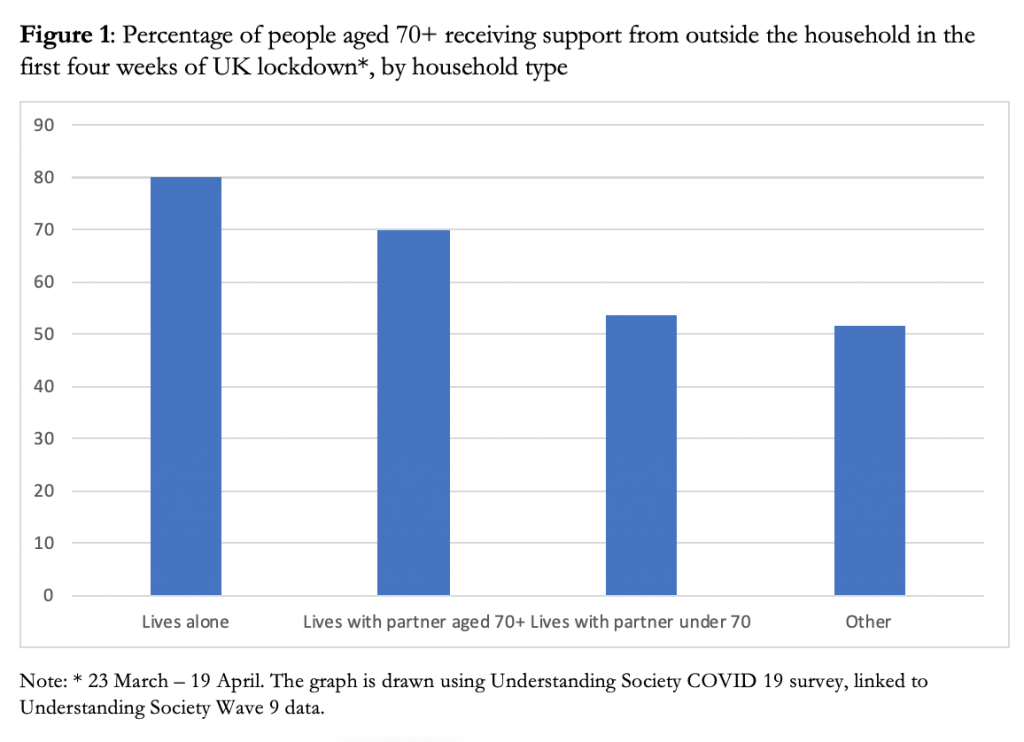Maria Evandrou, Jane Falkingham, Min Qin and Athina Vlachantoni highlight the experiences of older people who did not quality for formal home care visits during the lockdown. They find that while many did receive assistance with activities such as shopping (and some received more such help than previously), a small group were at risk of not having the support they needed, something which may be repeated in future lockdowns.
On 23 March 2020 the UK went into lockdown in an attempt to limit the spread of COVID-19. Government advice at that time was that all people aged 70 and over should stay at home and avoid any contact with non-household members. We analysed new data from the Understanding Society COVID-19 survey collected in April 2020, linked to Understanding Society Wave 9 data collected in 2018/19, in order to examine the extent of support received by individuals in this age group in the first four weeks of lockdown and how that support had changed prior to the outbreak of the pandemic.
The results highlight both positive news but also cause for concern. The receipt of assistance with Instrumental Activities of Daily Living, especially shopping, has increased particularly among those living alone or with an older partner, reflecting the rise of volunteering and community action during this period.
In the first four weeks of lockdown, two-thirds (67%) of survey respondents reported that they had received support from family, neighbours or friends who did not live in the same house. The proportion of older people receiving support varied according to the type of household they lived in. Four in five (80%) older persons living alone reported having received support, while amongst those living only with a partner also aged 70 plus, 70% received support. This fell to just over half of those living with a partner younger than 70 (54%) and those living with others (52%). The new evidence paints a positive picture, but it also illustrates that one in five persons over 70 living alone did not receive any support from informal sources outside their household (Figure 1).
When asked to compare their current help and support with that received prior to the pandemic, just over a quarter of respondents (27%) reported receiving help from family, friends or neighbours who did not previously provide help. Just under a fifth (17.7%) reported receiving more help from people who had previously helped. Only a small minority (4.1%) reported receiving less help, and around a half (51%) reported no change in care receipt. Once more, there were significant differences by household type, with those living alone or only with a partner aged 70 and over more likely to report receiving support from both people who had and had not previously helped. Worryingly, we found that older people living alone were the most likely to report receiving less help compared to those living in other household types (Figure 2).
To capture ‘needs’ unrelated to the lockdown, we examined respondents’ care needs prior to the pandemic. We did this by investigating whether they reported difficulties performing activities of daily living (ADLs) – everyday tasks generally involving functional mobility and personal care (e.g. bathing, dressing, toileting, eating) and instrumental activities of daily living (IADLs) – life functions necessary for maintaining a person’s immediate environment (e.g. shopping, cooking, laundering, housecleaning, gardening). We found a clear association between difficulties in performing activities of daily living and receipt of support, with those respondents who reported difficulties in performing two or more ADLs or IADLs prior to the pandemic, being more likely to receive help than those with no such difficulties (Figure 3).
Amongst persons aged 70+ reporting difficulty with two or more IADLs, 94% of those living alone received support from outside the household, compared to 88% of those living with a partner also aged 70+, 69% of those living with a partner aged under 70, and 44% of those living with other adults. So, those ‘most in need’, i.e. those living alone and with need, were most likely to receive help with instrumental activities of daily living, such as shopping. However, 17% of older persons living alone who reported two or more difficulties with personal care tasks did not receive any external informal assistance.
Policy Implications
Previous research has shown that statutory social services are being increasingly concentrated on those with the highest level of need. There is a danger that during the pandemic, older people with more moderate needs may slip under the radar of the formal safety net; with non-co-resident informal carers unable to visit during lockdown, there may be a small but vulnerable group of incapacitated older people whose needs for daily living are not being met. This in turn may manifest itself in falls and other unanticipated visits to hospital A&E, negating the benefits of shielding during lockdown.
_________________________
Note: the above draws on the authors’ paper available here. For further information see also the authors’ CPC Briefing Paper.
Maria Evandrou is Head of the Department of Gerontology at the University of Southampton.
Jane Falkingham is Dean of the Faculty of Social Sciences and Professor of Demography and International Social Policy at the University of Southampton.
Min Qin is a Research Fellow for the ESRC Centre for Population Change and the Centre for Research on Ageing at the University of Southampton.
Athina Vlachantoni is Professor of Gerontology and Social Policy at the University of Southampton.
All articles posted on this blog give the views of the author(s), and not the position of LSE British Politics and Policy, nor of the London School of Economics and Political Science. Featured image credit: by CDC on Unsplash.









